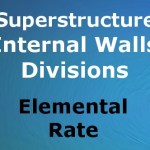
The Approximate Quantities method of estimating the cost of a construction project is regarded as the best because it’s more accurate and more reliable than other methods of estimating. This estimate is based on measurement groups where Bill items with the same dimensions (in metres or square metres) are grouped together. This essentially means that items occupying the same area or perimeter are measured together at once using a Group unit of measurement.
If you are familiar with an Elemental Estimate, you should know that Building Elements consist of major Elemental Items which are composed of items occupying the same area or length. Items which cannot be mapped to the Group area or length (Elemental area or length) are measured separately, for example reinforced concrete columns, bases, staircases, door steps, windows, doors, eaves, flashings, downpipes, cornices, built-in cupboards, kitchen fittings, sanitary fittings, cold water supply, hot water supply, geysers, steel balustrade and sundries. Most of these items are enumerated (measured in number), but as long as the surface area or linear dimension cannot be mapped to the Group area or length, it will be measured separately regardless of how it’s measured. Just like major items, separate items should be linked to associated items as much as possible, for example Eaves should include fascia board, gutters and painting. Doors should include door frame, ironmongery, painting on door, plaster/paint to reveals and adjustments for wall openings. Windows should include cills, lintels, glazing, painting, plaster/paint to reveals and adjustments for wall openings.
The same concept can be applied to Approximate Quantities, however the difference is that the grouping of Approximate Quantities is much more flexible, it should not necessarily follow the Elemental format. For example, in an Elemental Estimate, you cannot group Roofs with Ceilings & Soffits, but in the Approximate Quantities method, you are free to group the two. The Structural Frame (Slabs) cannot be grouped with Ceilings & Soffits, but you can group them together in the Approximate Quantities method.
Since this estimate is based on a group of items which are combined together, the rate for each group (composite rate) is also a combination of individual item prices. These component items are BOQ items. In this estimate, the procedure for building up composite rates will take a large part of the Quantity Surveyor’s time, and therefore it requires more work than the Superficial Area method. However, although you will spend the initial period building up rates for a project, most of the rates can be applied to a new project which is similar in nature, so you will only be required to do minor rate adjustments and editing.
Composite Rate Build Up Procedure
There are principles that you have to follow when building up composite rates for Approximate Quantities. We are going to illustrate a composite rate build-up for Foundations:
Excavate trench 600mm wide and 700mm deep, with 200mm thick concrete footings, 230mm foundation brickwall 800mm high and facebricks on plinth 300mm high.
Step 1
First, you have to determine the Group unit of measurement. For example when you are measuring Foundations in Elemental or Approximate Quantities estimating, the group unit of measurement is the metre (m).
Step 2
The second step is listing all associated Bill items that can be mapped to Foundations by length. These are:
- Trench Excavation – (m3) Rate – R27.50
- Risk of collapse/Earthwork support – (m2) Rate – R2.00
- Compaction – (m2) Rate – R5.00
- Ant Poisoning to bottoms and sides of trench – (m2) Rate – R7.00
- Backfilling – (m3) Rate – R35.00
- Cart-away surplus material from excavations – (m3) Rate – R30.00
- Concrete footings – (m3) Rate – R1200.00
- One Brickwall in Foundations – (m2) Rate – R235.00
- 150mm wide Brick reinforcement – (m) Rate – R2.50
- Facings on plinth area – (m2) Rate – R50.00
- DPC – (m2) Rate – R7.00
Step 3
Since your Group unit is the metre (m), you should convert the Bill item rates to Cost per Metre.
| Rate Build Up
GROUP – FOUNDATIONS |
Rate – Cost Per Metre (m) Rands |
| 1m of Trench Excavations: | |
| 600 x 700 x 1000 | |
| 0.6 x 0.7 x 1 = 0.42m3 | |
| 0.43m3 x R27.50 = R11.83 | 11.83 |
| 1m of Earthwork Support: | |
| (700)2 x 1000 | |
| (0.7) 2 x 1 = 1.44m2 | |
| 1.44m2 x R2.00 = R2.88 | 2.88 |
| 1m of Compaction: | |
| 600 x 1000 | |
| 0.6 x 1 = 0.6m2 | |
| 0.6m2 x R5.00 = R3.00 | 3.00 |
| 1m of Ant Poisoning: | |
| Bottom 600 x 1000 = 0.6 x 1 = 0.6m2 | |
| 0.6m2 x R7.00 = R4.20 | 4.20 |
| Sides (700)2 x 1000 = (0.7)2 x 1 = 1.4m2 | |
| 1.4m2 x R7.00 = R9.80 | 9.80 |
| 1m of Backfilling: | |
| 600 – 230 = 370 | |
| 700 – 200 = 500 | |
| 370 x 500 x 1000 | |
| 0.37 x 0.5 x 1 = 0.185m3 | |
| 0.185m3 x R35.00 = R6.48 | 6.48 |
| 1m of Cart-away from Excavations: | |
| 700 – 200 = 500 | |
| 500 x 230 x 1000 | |
| 0.5 x 0.23 x 1 = 0.115m3 | |
| 0.115m3 x R30.00 = R3.45 | 3.45 |
| 1m of Concrete Footings: | |
| 600 x 200 x 1000 | |
| 0.6 x 0.2 x 1 = 0.12m3 | |
| 0.12m3 x R1200.00 = R144.00 | 144.00 |
| 1m of One Brickwall in Foundations: | |
| 800 x 1000 | |
| 0.8 x 1 = 0.8m2 | |
| 0.8m2 x R235.00 = R188.00 | 188.00 |
| 1m of 150mm wide Brick reinforcement: | |
| 1m = R2.50 | 2.50 |
| 1m of Facings on plinth area: | |
| 300 x 1000 | |
| 0.30 x 1 = 0.30m2 | |
| 0.30m2 x R50.00 = R15.00 | 15.00 |
| 1m of DPC: | |
| 230 x 1000 | |
| 0.23 x 1 = 0.23m2 | |
| 0.23m2 x R7.00 = R1.61 | 1.61 |
| Composite Rate – FOUNDATIONS | 392.75 |
In the above example, the composite rate for the group Foundations is R392.75 per metre.
**Bill items which cannot be mapped to the Group unit (m) are measured separately. These are:
Site Drainage:
- Keeping excavations free of water (item)
Extra over excavations:
- excavating in soft rock (m3)
- excavating in hard rock (m3)
Using the same principles, you should proceed to build up rates for other elements or groups in your construction project. Remember that your grouping of items doesn’t have to be strictly elemental:
- Foundations
- Ground Floor Construction,
- Structural Frame,
- External Envelope,
- Roofs,
- Internal Divisions
- Floor Finishes
- Internal Wall Finishes
- Ceilings and Soffits
- Fittings
- Internal Plumbing
- External Works:
- Soil Drainage
- Water Supplies – Site Reticulation
- Boundary, Screen and Retaining Walls
- Roads, Pavings, Etc
Just like all estimates, the Quantity Surveyor has to include Preliminaries and Provisional Sums and add Contingencies to the Subtotal.
When to Use Approximate Quantities
This estimate can be used for cost planning purposes during the advanced design stage when full drawings and specifications have taken shape. If you are measuring a large project that would take too much of your time in preparing full Bills of Quantities, the fastest way to produce an accurate multiple-rate estimate is to use the Approximate Quantities method. Besides big construction projects, this method is recommended for measuring extensive renovations and refurbishments.
An Estimator who works for a construction firm can also use this method to prepare Bills of Approximate Quantities that can be used for tendering or negotiating with the client. These bills are known by different names, such as Bills of Inclusive Quantities or simply Builder’s Quantities.
Advantages of Approximate Quantities Estimating Method
- This estimate is more likely to be accurate and reliable than other methods because it is based on advanced drawings.
- BOQ items are used in creating Measurement Groups. This linking allows the estimate to be closer to the BOQ tender value.
- Group units of measurement allow the estimate to be measured and completed faster than a normal BOQ.
- A reliable estimate for major renovations and refurbishments.
- Estimate is not restricted by measurement rules, which gives the Quantity Surveyor freedom to group and measure items the way he/she likes. As an example, instead of applying percentage additions for sundries or measuring non-mappable items as Extra Over items, you can measure them separately.
Disadvantages of Approximate Quantities Estimating Method
- Unlike an Elemental Estimate, rules for grouping items and measurement are not standardized, therefore the structure may be slightly different between Quantity Surveyors.
- The composite rate build-up takes a lot of the Quantity Surveyor’s time.
- Depending on who prepared the estimate, some Estimators may ignore items which they deem to be insignificant, creating discrepancies in the estimated value.
- Assessing the percentage addition for sundries is hard as it cannot be measured. It takes an experienced quantity surveyor to estimate the right amount.



![Elemental Method of Estimating – Advantages and Disadvantages [Building Construction] House Under Construction Walls and Roof](https://i0.wp.com/estimationqs.com/wp-content/uploads/2017/04/House-Under-Construction-Walls-and-Roof.jpg?resize=150%2C150&ssl=1)






